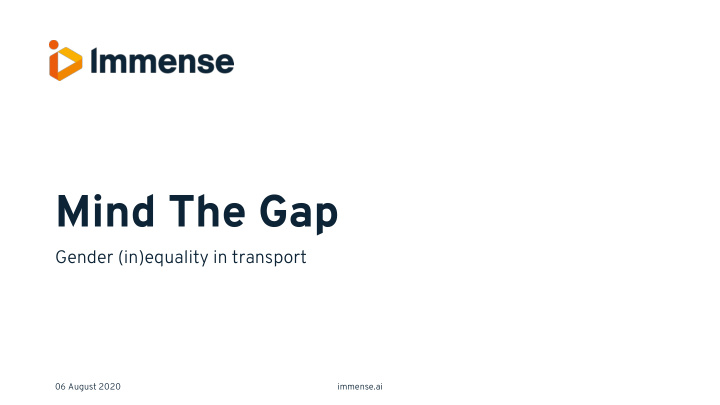



Mind The Gap Gender (in)equality in transport 06 August 2020 immense.ai
Motivation… EEH wishes to fulfil these three core principles: • Economic growth • Accessibility and inclusion • Quality of life and environment But first… immense.ai 2
Can snow clearing be sexist? Surely not? • In 2011, Sweden introduced a gender equality initiative. • One official in the town of Karlskoga joked: • “at least snow clearing would be spared scrutiny by the ‘gender people’..” This actually prompted the local authority to re-evaluate their snow clearing policy • They found it disproportionately affected women • They changed their policy to clear pedestrian routes before roads: • “It wouldn’t cost more money and it’s easier to drive through three inches of snow than to push a buggy” They also found this approach saved money. • (public health and gained productivity vs road maintenance) 1 (Perez, 2019) immense.ai 3
Women are dissatisfied with transport 2013 European commission report: • “Europeans satisfaction with urban transport” 2 (European Comission, 2014) Women across Europe Dissatisfied • Safety Concerns 3 (DFT, 2004) • Inaccessible • Does not work for their schedules • 4 (CiViTAS, 2020) 5 (House of Commons, 2019) immense.ai 4
What makes women’s transport behaviour different? Women 26% more likely to trip • chain, 39% if child over 9 in household. 1 (Perez, 2019) Women feel unsafe using public • transport after dark 3 (DFT, 2004) Men dominate the use of cars in • hetero-couple single car households 4 (CiViTAS, 2020) Women more often work part time • and may need transport previsions Typical schedules for men and women in eastern Europe 4 outside of peak hours 4 immense.ai 5
Many of our models don’t work. Women’s trip behaviour is, on average, very different • to men’s. Women are much more likely to take many shorter • trips between many destinations. Known as trip chaining. Simple models fail to account for more complex trip • behaviour. This disproportionately effect women. Some models generate trips between zones but do • not account for intra-zonal trips. We also calibrate and inform our models using data • that can be incomplete or non-gender disaggregated 6 (Dois Ortuzar & Willumesn, 2011) immense.ai 6
Why data is part of the problem Transport data is often not gender-disaggregated or • incomplete. We will often accept car user data as representative of trips • for a population. This excludes those who do not take cars. Often women. Britain actually very good at this, which is noted in • CIVITAS’s policy note “Gender equality and mobility”. Good, rich data is often expensive or just doesn’t exist. Data • being such a commodity is problematic, we can’t act on information we don’t have. immense.ai 7
Concerns around safety A French study found 87% of women had • been harassed in some form on public transit 2004 DFT study found “stark differences • in perceived safety after dark” 3 (DFT, 2004) MERGE Greenwich report also noted • women felt much less safe using rideshare services 7 (Merge, 2018) New technologies and infrastructure must • account for these concerns immense.ai 8
UK? EEH!? Part time work. Night safety. NTS is good. Need gendered data. Health and Social. Sexual Assault. Need to re-evaluate Carer roles. Other Harassment. Models. 4 (CiViTAS, 2020) 1 (Perez, 2019) 5 (House of Commons, 2019) 3 (DFT 2004) 4 (Civitas, 2020) immense.ai 9
Some examples of good practice 2002 Swedish city of Malmo decided to gender-mainstream the process of • developing the cities public transport What ensued was a series of “dialogue meetings” • Chose to engage in dialogue with female dominated workplace. For this they chose a hospital • Many women from the hospital and female high-school students expressed • feeling unsafe on public transport at night. The municipalities have taken action on this in such ways as: • Removing bushes and shrubbery near stops • Removing dark passageways to stops • Stopping between stops at night • The dialogue meetings had unintended benefits • 4 (Civitas, 2020) immense.ai 10
Some examples of good practice 2005 City of Bolzano, Italy, set up the Time and • Schedules Plan. Series of initiatives with a focus on women’s • travel needs: “taxi -rosa ” (pink taxi), in the evening and • night hours for a discounted fare “ parcheggi-rosa ” (pink parking) easily • accessible women only car parks around the city in well lit areas. 4 (Civitas, 2020) immense.ai 11
What can WE do…? Detailed statistics • Increase safety and security • More research • Enhance pedestrian areas • Raise awareness • Affordability for multi-trips • Dialoguing • Non-rush-hour timetabling • Assessment and Auditing • Dedicated services • immense.ai 12
Why is this important to EEH 'connecting people and places with opportunities and services' Better transport increases “choice” in employment and benefits local economies. 8 (DEMAND, 2015) ‘…the views of our people and businesses.. are so important at this stage in the process.’ Dialoguing with specific groups is shown to give great insights. ‘Improving the life chances and opportunities of our residents, no matter what their circumstances.’ Women make up 48% of our work force and more than 50% of our population. If new infrastructure, services and policy does not work for them. It will struggle to succeed. The way forward has to include looking at change through a gendered lens. immense.ai 13
Better transport for women… …is better transport for all! Thankyou for listening. immense.ai 14
Recommend
More recommend